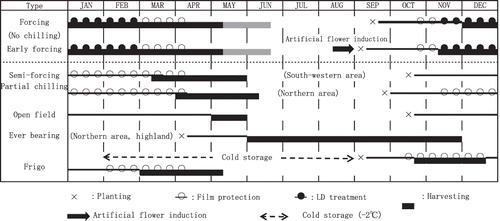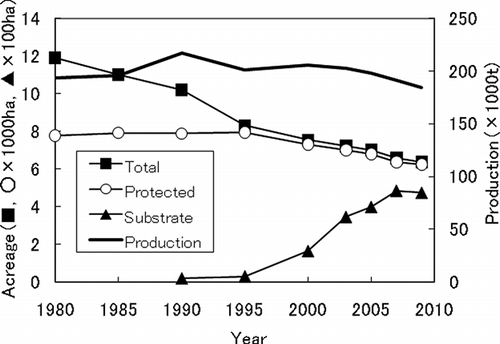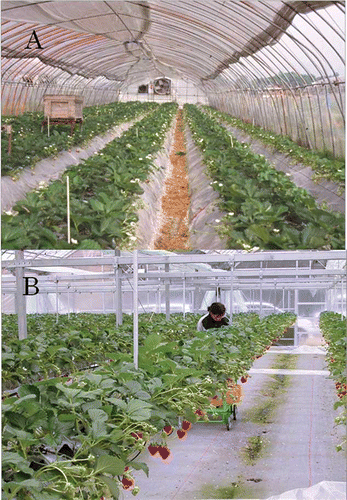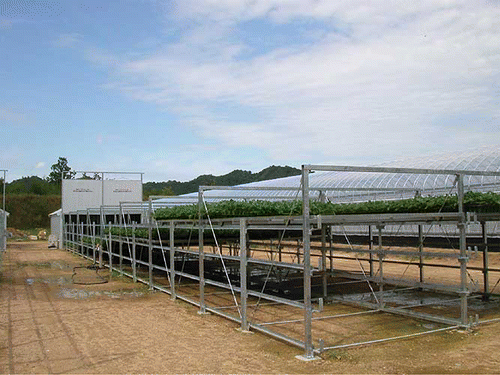Abstract
In Japan, there are more than 25,000 strawberry farms totaling 6360 ha. Over 95% of the acreage is in an annual hill culture system and covered with polyethylene plastic to force June-bearing cultivars, such as Tochiotome and Saga-honoka to produce fruit from late fall to early summer. In the late 1960s, a forcing technique was developed that advanced flower bud initiation to late summer and prevented the transplants from becoming dormant in the winter. The new forcing technique involved nitrogen starvation of nursery plants, growing the transplants in walk-in tunnels with no chilling and a long-day photoperiod condition, and applying gibberellic acid before the onset of endodormancy. Until about 1970, strawberry growers in Japan used runner plants produced in waiting-beds, but now most of the transplants are produced in plastic pots to avoid soil-borne diseases. Recently, the use of tray plants produced from hanging runner cuttings has become popular. Most of the strawberries in Japan are grown in soil using the annual hill culture system. To offer better working conditions for plant management and fruit picking, low cost substrate culture systems and bench-top production systems are now used by over 1,800 farmers throughout Japan totaling over 470 ha in production.
INTRODUCTION
In Japan, forcing culture of early-fruiting, June-bearing cultivars is the predominant method of producing strawberries (). The majority of strawberry farms are small (<0.2 ha), family-operated, and grown along with rice and other horticultural crops. Strawberry farmers in Japan pick and package the fruits by themselves. The Japanese strawberry cultivars produce soft fruit as compared to U.S. or European cultivars. Therefore, the fruit must be picked and packaged carefully. The Japanese strawberry farmers have had difficulty in hiring good laborers to pick strawberry in a soil-based hill culture system. The bench-top, substrate production systems have been increasing constantly for the past few decades and some growers are starting large-scaled production with an industrialized substrate system. While it is difficult to employ careful workers for soil production, it is not so difficult for substrate production. Breeding programs and physiological, ecological, and horticultural research have been conducted all over Japan (2 national laboratories, Kurume and Morioka; nearly 40 prefectural experimental stations; 4 universities; and several private companies) to increase early yield and to meet the demand for strawberries during the Christmas holiday season. This report provides an overview of the history of forcing culture systems in Japan and recent progress in strawberry breeding and forcing culture production to increase early season fruit yield.
FIGURE 1 Different cropping programs used in Japan to produce strawberries. Adaptations of June-bearing cultivars for winter fruit production using the forcing culture system and fruit production from ever-bearing cultivars from summer to fall in cooler climates have enabled the Japanese strawberry industry to deliver fresh strawberries to the market all year around.

HISTORY
Cultivated strawberry (Fragaria x ananassa Duch.) was introduced to Nagasaki, Japan in the early 19th century. Several cultivars, such as Excelsior, Marshall, and Victoria, were introduced to the National Industrial Station in 1872 and 1875 and commercial fruit production began around 1900 in the Kanto region surrounding Tokyo. In 1899, Dr. Hayato Fukuba selected the first Japanese cultivar, Fukuba, from the selfed progenies of General Chanzy. It is a very early June-bearer and was the main cultivar for 70 years for the unique forcing-winter production of strawberry that had plants growing in stone walls (Ishigaki-saibai) that was developed in 1904 in Kuno-san, Shizuoka (CitationMochizuki et al., 2007).
In the 1950s, polyvinyl chloride (PVC) film was introduced into the low tunnel production of strawberries, which popularized the semi-forcing culture in walk-in tunnels and fruit could be harvested from March to May. For the semi-forcing culture, strawberry transplants were established in October and covered with a PVC film in January after the chilling requirement was fulfilled. Donner and Hokowase, which require 400 and 600 hr of chilling below 5°C, respectively, were the two main cultivars for semi-forcing and open-field production in eastern and western Japan, respectively.
In early 1970, a new forcing procedure that enhanced early flower-bud was developed for Hokowase, which easily goes into dormancy in the winter season (CitationFujimoto, 1971). This forcing production technique was quickly adopted all over Japan, and Hokowase become the leading cultivar and accounted for more than 50% of total fruit production until early 1980 (). For this forcing culture system, runner plants were raised in waiting beds until July, dug up, and then replanted in the same beds in early-September. In this transplant manipulation technique called “Dankon-zurashi,” early flower-bud initiation was promoted by reducing the plant nitrogen level (CitationFujimoto and Kimura, 1970). The waiting-bed plants with flower buds already initiated were planted in raised beds in late September. The plants remained in the open until the initiation of secondary inflorescence on developing lateral branch crown. The beds were covered with the PVC film in late October to maintain the growing environment above 5°C and the plants were treated with gibberellic acid (10 mg·L−1) and held under long photoperiod conditions to force plants to continue growth and prevent plants from going into dormancy ().
TABLE 1 Modern Japanese Strawberry Cultivars with Their Release Date and Changes in the Percent Acreage Planted to These Cultivars from 1982 to 2009Footnote z
In the mid 1970s, Fusarium wilt became a major fungal disease problem in Japan. This disease was brought to control by adopting soil solarization practices and producing transplants in pots (CitationArai et al., 1980; CitationKodama and Fukui, 1979). These practices increased labor costs but were found to be quite reliable against the infection of Fusarium or other soil-borne pathogens. Propagation and distribution systems of tissue cultured, disease-free stock plants were also established during this time.
In the mid 1980s, new early June-bearers, Toyonoka and Nyoho, replaced Hokowase (). The two new cultivars required only 50 to 100 hr below 5°C, and their productivity, earliness to harvest, fruit quality, and shelf-life were proven to be superior to Hokowase. For these two cultivars, light and low temperature treatments for flower-bud induction were modified as described later. Nyoho and Toyonoka strawberry accounted for more than 90% of total production for nearly 10 years.
During this period, new breeding programs for early June-bearer and ever-bearer were begun by prefectural agricultural experimental stations and private companies. Some of the early-fruiting cultivars, such as Akihime (1992), Sachinoka (1996), and Tochiotome (1996), became popular and replaced Nyoho and Toyonoka (). Most of the new releases are now grown continuously on annual hills with the soil to which the plant matter is incorporated. Soil fumigation is conducted in August with chloropicrin or solarization.
The importance of soil improvement with organic amendments has been recognized by exemplary growers obtaining high yields. They have been applied additional organic substances (e.g., 10–15 t/ha of rice straw and >40 t/ha of bark compost or sorghum plants as a green manure). Such organic amendments and about 20 to 30 t/ha of farmyard manure are applied before and after the fumigation, respectively. Organic substances improve chemical, physical, and biological functions of the soil, but growers could not recognize the other effect of organic substances. Recently, the importance of organic substances as a source of CO2 in greenhouses and the significance of elevated CO2 in the PVC film covered poly houses was recognized and was quickly adapted by the Japanese strawberry growers (CitationYoshida and Morimoto, 1997a; CitationYoshida et al., 1997b, Citation2006; CitationItani et al., 1999).
CURRENT PRODUCTION AND CULTIVARS
The acreage in strawberry production peaked around 1980 in Japan when the growers adapted the forcing culture technique for Hokowase strawberry. Since then, the acreage in strawberry has been steadily declining. First, growers using the semi-forcing technique for Hokowase and Donner have declined (). Since 1995, the acreage for forcing culture has declined at an annual rate of 1.6%. However, the reduction of total fruit production was not so large. Mean price of strawberry at the Tokyo Metropolitan Central Wholesale Market has ranged from ¥1,000 to ¥1,100 ($12–14)/kg (). The volume of strawberries delivered to the market is largest in March, but the price is lowest from April to June. Usually shelf-life and fruit quality drop as the temperatures become warmer as summer approaches. However, the market price rises from August to December as strawberry production declines in late summer. During this period in 2000, more than 5,500 t of fresh strawberries were imported, however, import of strawberries from August to December decreased to less than 3,000 t in 2009. The decline in imports has been due to an increase in summer to autumn production from the newly released Japanese ever-bearing cultivars.
FIGURE 2 Annual strawberry production (MT) and the acreage in different production systems during the period from 1980 to 2010 (Ministry of Agriculture, Forestry and Fisheries, Japan). Note the production has been steady but the acreage used for strawberry cultivation has declined during this period. Scale of acreage is different in substrate from total and protected production.

FIGURE 3 Monthly mean price and supply of strawberries at the Tokyo Metropolitan Wholesale Market. 1,000 JP Yen = 12 $US in February 2011.

Among the June-bearing cultivars used for the forcing culture, Tochiotome has replaced Nyoho and has been the leading strawberry cultivar in Japan for the last decade. Many public or private breeding programs were started in the 1990s. In the last 10 years or so, these regional public breeding programs have released the large fruited cultivars, such as Saga-honoka (Saga, 2001), Beni-hoppe (Shizuoka, 2002), Yumenoka (Aichi, 2005), Fukuoka-S6 (Ama-oh®; Fukuoka, 2005), Kumaken-I 548 (Hinoshizuku®; Kumamoto, 2006), and Kotoka (Nara, 2009). The acreage of these new cultivars in production has changed dramatically (). New cultivars that are released by a prefectural experimental station tend to be grown in that prefecture as the prefectural government owns the patent rights and promotes local strawberry production. New publicly released cultivars have high productivity and fruit quality, however, most were not resistant to anthracnose and Fusarium wilt. Recently, anthracnose resistant cultivars Kaorino (Mie, 2008), Karen-Berry, Ohkimi (NARO, 2008), and a powdery mildew resistant F-1 hybrid Chiba F-1 (Chiba, 2008) were released.
GREENHOUSE STRUCTURE AND PLANT PROPAGATION
When forcing strawberry production began in 1970, strawberries were initially grown in small walk-in tunnels, 4.5–5.4 m wide, 20–50 m long, and 2–2.5 m high (). These tunnels were permanent structures usually constructed of 19.1 mm (0.75 in.) steel bows and purlins and erected in paddy fields. Flower induced waiting-bed plants are planted in late September on annual hills and the tunnels are covered with a PVC film in late October (CitationFujimoto, 1971). The reasons for the delay in covering the tunnels with a plastic film until October are that the typhoon season lasts until late September and the high temperatures until October can delay flower bud differentiation on the lateral branch crown.
FIGURE 4 Examples of strawberry production systems in Japan. (A) Forcing annual hill production system in a typical walk-in tunnel (width 5.4 m, height 2.1 m, Miki, Kagawa on March 2000), and (B) soil-less, peat-bag culture system on bench-top, shown here inside a greenhouse with ‘Nyoho’ strawberry at the NOZOMI Farm in Okayama prefecture (photograph taken January 2006) (color figure available online).

Recently, strawberry growers began using solid multi-spanned plastic greenhouses constructed with thicker pipes or steel frames and covered with mulch layered polyolefin (PO) films. Bench-top substrate production systems are usually introduced into such types of greenhouses (). Rain shelters have been used for propagating pot plants to reduce anthracnose infection by splashing of rainwater. Nitrogen fertilization is terminated for pot plants under the shelter in late August to promote flower bud induction.
The use of tray plants grown from cuttings of runner tips has become increasingly popular with the increase in production of strawberries with substrate culture systems. The tray plants have come down in price and are easier to control diseases and handle than the conventionally produced pot plants and waiting-bed plants (CitationYoshida and Motomura, 2011). Mother plants are established in bench-top substrate culture. Runner tips with two to four expanded leaves are excised from mother plants, planted (plugged) in cell trays, and frequently irrigated until they root. In Kagawa Prefecture, the growers prepare 1,000 to 2,000 disease-free mother plants to produce around 10 times of runner tips that would be sufficient to 10% to 20% of transplants needed for 1 ha of greenhouse strawberry production. The remaining 80%–90% of the transplants is propagated from disease-free plants that had produced fruit the previous season. By using these propagation procedures, the labor cost for transplant production has been reduced to less than 50% of producing conventional pot plants, which requires 4,000 to 5,000 labor hr/ha for 100,000 transplants.
Several simple techniques have been developed to enhance flower bud initiation. One practice is to grow the transplants at high elevation sites “Yama-age” where cooler temperatures prevail in the summer and partial root pruning in the waiting bed “Dankon-zurashi” (CitationFujimoto and Kimura, 1970). Early flower bud initiation can be induced in pot-raised transplants by nitrogen starvation (CitationArai et al., 1980). Also, artificial low temperature treatments, either by exposing transplants daily to 16 hr of low temperature (LT) ranging from 10 to 15°C in the dark and 8 hr of ambient light [Short-Day (SD)] and temperatures (SD–LT) followed by 10 to 15 days of continuous low-temperature (10 to 15°C) in a cold room (CitationFushihara et al., 1989; CitationShishido and Kumakura, 1989).
A stable flower-inducing effect can be obtained by SD–LT (), as the duration of treatment can be easily controlled, but expensive equipment (“Yorei-ko” night cooling chamber) is required for the treatment (). The cost of LT storage is much lower, as it can be conducted with prefabricated cold rooms that have been used for pre-cooling of shipping fruits. However, the cold inductive stimulus can be insufficient when the plants are treated for a long period (CitationIto and Saito, 1962; CitationFuruya et al., 1988). LT storage and SD-LT are popular in Kyushu (the most western) area and the other, the eastern and central, area of Japan, respectively. Such early forcing techniques () have been adopted for 5% of protected strawberry production totaling 250 ha.
TABLE 2 Share of Major Substrate Culture Systems in Japan (2003)
SUBSTRATE PRODUCTION SYSTEMS
Bench-top production systems were expected to replace the annual hill culture systems because they offer better working conditions for plant management and fruit picking, and work can be performed while standing. Nutrient film technique (NFT) and rock-wool culture were introduced to several production areas in the 1980s, but these two systems were not adopted by the growers due to low productivity and high initial cost, respectively. In the mid 1990s, the low-cost substrate culture system called the “Rakuchin” (meaning “easy” in Japanese) production system that used peat-bags, artificial CO2 enrichment, and a drip fertigation controller based on solar radiation, was introduced to Japan by modifying the European systems for Japanese environments and cultivars (CitationYoshida et al., 1996). Strawberry production in substrate production systems has increased in Japan peaking at 485 ha of greenhouses in 2009 ().
Various planting containers, beds, and substrates developed by private companies, prefecture experimental stations, and by growers are being currently used in Japan. These systems can be classified into two groups (). The first group uses a relatively small amount (∼2 L/plant) of peat-based substrate, and nutrient solution is applied automatically. In the former, fertigation and greenhouse environments are usually controlled automatically with a computer, and large industrial strawberry production is realized by some growers. The second group uses about 4 to 5 L/plant of substrate other than peat moss with lower water holding capacity and the nutrients are provided with slow-release fertilizers incorporated in the substrate and irrigation water is controlled manually by growers. When grown in a large amount of medium, strawberry plants do not have to be grown with strict water and nutrient control. The growers typically schedule fertilizer and water application similar to ones used for the annual hill culture.
TABLE 3 Effect of short day–low temperature (SD–LT) and dark–low temperature (Dark) treatments on flowering of June-bearing strawberry cultivars (National Institute of Vegetable and Tea, 1995)
LITERATURE CITED
- Arai , K. , Matsuo , S. and Matsuda , T. 1980 . Physiological studies in forced production of strawberry. VI. Earliness of fruit production in pot raised transplants . Agric. & Hort. (Nogyo-oyobi-Engei) , 55 : 561 – 562 . in Japanese
- Fujimoto , K. and Kimura , M. 1970 . Studies on flowering of strawberry. III. Effect of nitrogen on flower bud differentiation and development . Japan. Soc. Hort. Sci. Spring Meet. S45 , : 174 – 175 . abstr. in Japanese
- Fujimoto , K. 1971 . Studies on physiological and ecological characteristics of strawberry ‘Hokowase’ and development of new cropping type . Special Bull. Nara Agr. Exp. Stn. , 1 : 1 – 151 . in Japanese
- Furuya , S. , Yamashita , M. and Yamasaki , A. 1988 . Effects of nitrogen content on the flower bud initiation induced by chilling under dark condition in strawberries . Bull. Natl. Res. Inst. Veg., Ornamental Plants, & Tea D , 1 : 51 – 57 . in Japanese with English abstr
- Fushihara , H. , Shibato , Y. and Hayashi , M. 1989 . Studies on new forcing culture of strawberry using cooling treatment in summer season. 5. Effects of temperature and day length of flowering and yield in low temperature-dark treatment method . J. Japan, Soc. Hort. Sci. , 58 ( Suppl. 2 ) : 406 – 407 . in Japanese
- Itani , Y. , Hara , T. , Phan , W.N. , Fujime , Y. and Yoshida , Y. 1999 . Effects of CO2 enrichment and plant density on the yield, fruit quality and absorption of water and mineral nutrients in strawberry grown in peat bag culture . Environ. Control Biol. , 37 : 171 – 177 . in Japanese with English abstr
- Ito , H. and Saito , T. 1962 . Studies on the flower formation in the strawberry plants. I. Effects of temperature and photoperiod on the flower formation . Tohoku J. Agr. Res. , 13 : 191 – 203 .
- Kodama , T. and Fukui , T. 1979 . Solar heating sterilization in the closed vinyl house against soil-borne diseases. 1. The movements of soil temperature and determination of thermal lethal conditions for some soil-borne diseases . Bull. Nara Agr. Exp. Stn. , 10 : 71 – 82 . in Japanese with English abstr
- Mochizuki , T. , Okimura , M. , Yoshida , Y. , Yamasaki , A. , Takahashi , H. and Sugiyama , N. 2007 . Recent trends on strawberry cultivars and production technology in Japan . Acta Hort. , 761 : 107 – 113 .
- Shishido , Y. and Kumakura , H. 1989 . Studies on the flower bud formation and fruit development in strawberry. 2. Effect of temperature and duration in the continuous dark of low temperature treatment . J. Japan, Soc. Hort. Sci. , 58 ( Suppl. 2 ) : 408 – 409 . in Japanese
- Yoshida , Y. , Morimoto , Y. , Mizobuchi , T. , Kita , T. , Matsuzaki , T. , Kondo , H. , Kanaba , K. and Itogawa , K. 1996 . Construction of “Rakuchin,” a new type of strawberry substrate culture system of Kagawa. 1. Outline of the system, managements and cultivation, and yield of ‘Nyoho’ . J. Japan, Soc. Hort. Sci. , 65 ( Suppl. 2 ) : 44 – 45 . in Japanese
- Yoshida , Y. and Morimoto , Y. 1997a . Measurement, modeling and seasonal changes of canopy photosynthesis in ‘Nyoho’ strawberry . Acta Hort. , 439 : 575 – 582 .
- Yoshida , Y. , Morimoto , Y. and Yokoyama , K. 1997b . Soil organic substances positively affect carbon dioxide environment in greenhouse and yield in strawberry . J. Japan. Soc. Hort. Sci. , 65 : 791 – 799 .
- Yoshida , Y. , Morimoto , Y. , Yokoyama , K. and Ohnishi , T. 2006 . Positive effect of sorghum grown as a soil-improving crop on the CO2 environment in greenhouses and apparent photosynthesis of strawberry . Acta Hort. , 708 : 377 – 380 .
- Yoshida , Y. and Motomura , S. 2011 . Flower initiation in June-bearing strawberry as affected by crown depth, age and size of tray plants . J. Japan. Soc. Hort. Sci. , 80 : 26 – 31 .
